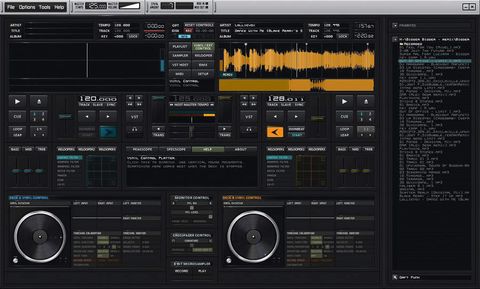When it comes to making Windows-based audio software, Image-Line certainly has plenty of experience. The company made their name with FruityLoops - a basic loop sequencing tool - and this later evolved into the fully-fledged DAW that is FL Studio. Now its sights are on a different market, namely the software DJing one.
Before you start to worry that Deckadance has been created by a bunch of 50-somethings trying to ‘get down´ with a younger generation, let us assure you that it was designed from the ground up by DJs for DJs. In fact, the basic layout will be familiar to almost anybody who has used any DJing software; there are only so many practical ways for form to follow function when it comes to applications like this, and there´s no point being different just for the sake of it. So, what features does Deckadance have?
Features
Like so many of its rivals, the software is built around two virtual decks. Each of these can accept files in MP3, WAV or OGG format. This might sound OK, but in this day and age, when there´s a variety of other formats being exchanged in cyberspace, we expected slightly more flexibility here.
Each deck has tempo analysis functions and auto-syncing, so beat-based mixing is incredibly simple in Deckadance. However, there´s much more to modern mixing than beat-matching, so you also get some handy looping tools (simply set the length value, engage the Loop button and you´re off). These actually work really well, and have a pleasantly ‘organic´ feel.
The loop function can be engaged at the exact moment you activate it rather than the nearest beat. Furthermore, with the Relooper you have a far more sophisticated looping tool: this slices the loop rhythmically and enables you to rearrange the looped audio currently playing back in the playback buffer. You can opt for organised mayhem or click the Randomize button, then add master effects for total sound mangling.
The results are very impressive, and quite useable, but we would caution against overusing this type of relooping effect. You might love it, but punters are likely to tire of it fairly quickly.
Unsurprisingly, Deckadance also has a full complement of mixing functions. You´ll find 3-band EQ and kill switches on each channel, and there´s a very comprehensive monitoring section. This even enables split-cue monitoring to ensure smooth mixing every time.
Speaking of monitoring, this obviously requires a multiple output soundcard. In fact, Deckadance can support up to six stereo output channels - Master Mix, Deck A, Deck B, Monitor, Loop Sampler and VSTi - which is pretty impressive. It´s ideal for people who prefer to use their laptop as a simple playback device and mix using a hardware mixer.
The output list we´ve just given you should have given away the fact that Deckadance has plenty more cool features in its arsenal. The first of these is a sample player: this enables you to place samples and loops into eight sample slots, or even to record them from the playback of Deckadance.
Another feature that helps Deckadance to stand out from the DJing software crowd is its ability to host VST instruments and effects - you also get some rather excellent built-in effects. However, the lack of extensive sequencing facilities means that you´re slightly limited in what you can do with instruments.
One final and very impressive feature of Deckadance is its support for hardware control. The software is designed to work with the most popular MIDI DJ controllers, and others can easily be assigned.
But as cool as MIDI control is, many DJs still prefer the feel of real turntables or CD decks (particularly scratch DJs), so we have to applaud Image-Line for making Deckadance compatible with a large range of timecoded vinyl and CD systems. It can even be calibrated to work with the those that it hasn´t been pre-configured to recognise.
Verdict
So, all the evidence so far points to the fact that Image-line has done a pretty stellar job with Deckadance, but there are one or two things we think they need to work on. Firstly, having just two decks is quite limiting - why not four? - and more GUI customisation options would be handy. You should also bear in mind that this is very much a live performance tool: it´s not ideal for creating editable mixes.
Fortunately, it´s easy to set these issues aside when you´re using Deckadance, as it´s a lot of fun. What´s more, at $179, it´s also pretty good value for money. This being the case, our advice to prospective PC DJs is to try out the fully-featured demo (Mac users should keep their eyes peeled for the forthcoming OS X version), as Deckadance´s blend of familiar and forward-thinking features might very well suit you perfectly.


